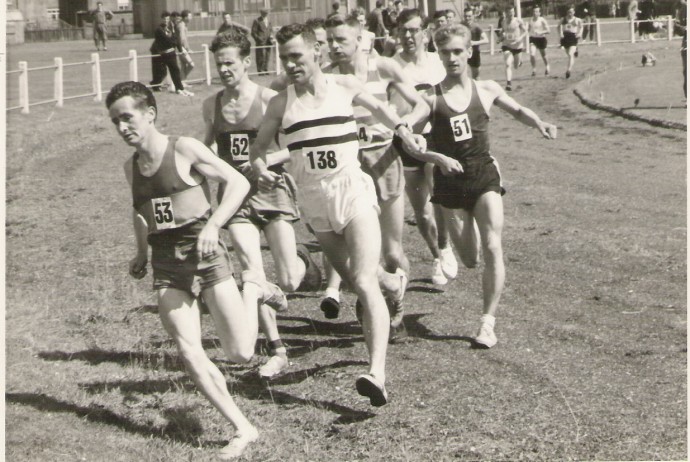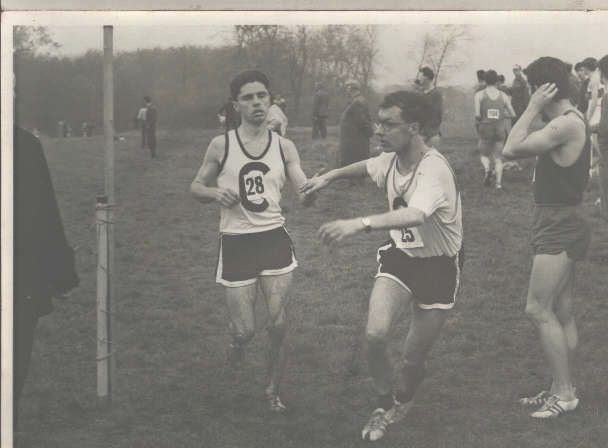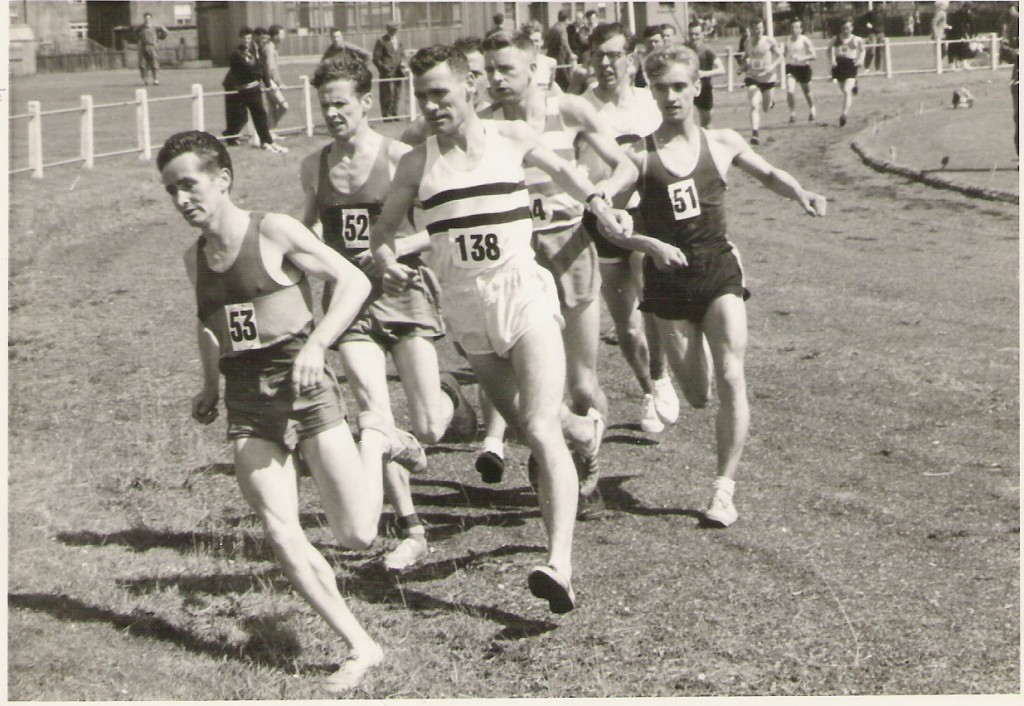Why me? Well a couple of people profiled commented that it was difficult to talk about themselves with the question about whether I ever did it? I had the same comment when I was doing books of profiles of Clydesdale Harriers so I eventually did a self-portrait. Thii is simply a reproduction of that, so when I mention ‘the club’ it’s Clydesdale Harriers I’m talking about.
Taking the baton from Neil Buchanan in the Midland Relays, 1960’s
When I joined the club in 1957 I was halfway through my two years National Service and running for the regimental cross country team. I had always been interested in sport – in post war Clydebank it was hard not to be. At that time we were exposed to all sorts of sport in the papers (there was coverage of football, boxing, cycling, athletics, golf and just about every sport conceivable in all the papers) and in the town itself there were three Junior football teams, the Harriers, the Swimming club and two swimming Baths, two cricket clubs, a boxing gymnasium, the Lomond Roads Cycling Club, two golf courses, a hockey team and tennis courts and putting greens in every public park and of course bowls. We lived in Singer’s Building (erected to house key workers from the factory) and among our neighbours were Junior football players, a boxer who appeared among the supporting bouts on many Glasgow Bills, bowlers, harriers, golfers of course and a cricketer. We were within easy distance of Glasgow with its six senior football clubs and there were annual sports meetings of note at Ibrox Park and at Shawfield Stadium. Nowadays football demands exclusivity and many of the above sports are not represented in the Burgh.
My favourite was always athletics with the local focal point being Singers Sports at the factory’s sports ground. They always had a top personality as a chieftain – one year it was Dorothy Lamour the Hollywood film star, another year it was June Foulds the Olympic sprinter for instance. There was also a lot of athletics on television and Dunky Wright reported on athletics on the Saturday evening ‘Sports Report’ on radio. I wasn’t good enough to join the Harriers like many of my schoolmates – Bobby Clark, Jim McDonald, Hudson Scott, Evelyn Graham, Ellen Gray and company were all Harriers with Bobby being quite outstanding. Moira Wright, John’s cousin, was in my class and every Monday would talk about John’s running with the Harriers.
At that time when boys became eighteen, they had to do two years National Service in the Army unless they were in a reserved occupation. I wasn’t and was called up for my National Service. It had us all running cross country on a frequent basis soon after call up. I liked it, found I was not too bad at it and then ran for the regiment in local cross country races, training five mornings a week before breakfast. (When we represented the regiment we were transported in the back of a three ton Army vehicle and given rations for the day of three sandwiches – one cheese, one with a fried egg in it and one with corned beef. No expense was spared.) Meanwhile Moira had been bugging me by post to join the Harriers and eventually I asked her to send me an application form. I sent it off with my five shillings membership fee and that was me in the club. On demob in September 1958 I went along with school friend Tom McAllister who had also been in the Army and was already a member of the club and we started regular training. Had it not been for National Service I would never have been a Clydesdale Harrier. Allan Faulds and several others have said that this ‘would have been great loss to the club’ and Allan insisted that I include the remark but my own thoughts are that there is always someone who will do the work. Training and racing with the club my philosophy soon became that of my mentor in the Harriers, David Bowman – one of the finest gentlemen ever to grace the sport – ‘do what your club needs you to do’. So I did a variety of things and it is easier to look at them in compartments although the reality was that they were often mixed in with each other or layered on top of each other. It was seldom if ever that only one role was filled.
First : as a runner
The usual winter pattern included the McAndrew Relays, the Midland District Relays and the County Relays (there was no National Relay then) with the Edinburgh to Glasgow eight stage road relay being the focus of the first half of the winter. The Nigel Barge race at Maryhill was at New Year and then the second half with the County, District and National Championships completing the season. The gaps were filled in with inter club meetings and club championships. The inter club meetings were held on a home and away basis and normally three packs (slow, medium and fast) went out. The usual clubs involved with us were Dumbarton, Vale of Leven, Greenock Glenpark, Springburn and the week before the National was always with Vicky Park and Garscube at Milngavie.
The usual winter pattern included the McAndrew Relays, the Midland District Relays and the County Relays (there was no National Relay then) with the Edinburgh to Glasgow eight stage road relay being the focus of the first half of the winter. The Nigel Barge race at Maryhill was at New Year and then the second half with the County, District and National Championships completing the season. The gaps were filled in with inter club meetings and club championships. The inter club meetings were held on a home and away basis and normally three packs (slow, medium and fast) went out. The usual clubs involved with us were Dumbarton, Vale of Leven, Greenock Glenpark, Springburn and the week before the National was always with Vicky Park and Garscube at Milngavie.
The start of the Dirrans Road Race: 53 Hugh Mitchell, 52 Pat McAtier, 138 Charlie McAlinden, 51 David Simpson, Bobby Calderwood
I had come into the sport to run and did just that and nothing else for a while: I ran road, cross country, track, and some hill running (Goat Fell once, the Mamore Hill four times). On the track, I ran in the County, District and National Championships at Three Miles, Six Miles and Ten Miles as well as the Marathon at the Scottish Championships. Preferring the roads and as a member of the Scottish Marathon Club I ran all over Scotland with the fixtures having a wider range of distances (if fewer races in total) than now when there are far too many 10,000 metres road races on the calendar. Then for instance there was the 10 miles Tom Scott Memorial and another 10 miles at Kirkintilloch Games, the 12 miles Marathon Club race at Springburn and at the Dundee ASA and of course at the Balloch – Clydebank, the 13 Miles at Dirrans Sports in Kilwinning, the 14 Miles at Gourock and at Shotts, 14½ at Dunblane, 15 at Babcock’s in Paisley, the 16 Miles of the Clydebank – Helensburgh, the 18 Miles at Rothesay, the 20 miles at Strathallan, the 22.6 miles from Edinburgh to North Berwick and the 30 miles plus of the Two Bridges Race. The Strathallan Race originally appeared on the entry form as being 20 miles, when you got there the programme said 21 miles but when you raced it you found it was really 22! They later owned up and it appeared as 22 miles on all documentation. Like all runners in search of a good marathon time I ran in marathons wherever I could including the Shettleston and Glasgow Marathons, the annual Scottish Championships from Meadowbank over various trails, in Rotherham in 1976 and Boston in 1977 and the Scottish Veterans Marathon at Bellahouston. But like the E-G the marathon running was more notable for the number and average time than for the quality of any one race. I did 15 or 16 marathons, was once outside three hours (Boston in 80 degrees heat) and twice outside 2:50, had a personal best of 2:32 and an average time of just outside 2:45. Of all the surfaces, I enjoyed the roads most – there was no necessity for a good sense of balance as there was in cross country, there was no crowd or other athletes watching you in action as there was on the track and I think I was better at it. It might be that my first two races ever influenced that preference: I ran in the McAndrew Relay and pulled in 21 places to be the fastest club runner. The following week it was the County Relays at Kirkintilloch and it was really dire. Mud everywhere unless you went off the trail somewhere – always a danger with me on the country.
I reckon that I ran about 1200 races for the club in total. I was proudest of doing 21 consecutive Edinburgh to Glasgows with my best running there being in the early 1970’s when I was not doing anything but run and race – ie no coaching or officiating. And of course the runners that I was racing with at that time were high quality athletes – Ian Donald, Doug Gemmell, Ian Leggett, Phil Dolan, Allan Faulds and the rest. The feeling of the E-G, including the weeks leading up to it was like nothing else in Scottish athletics and the demise of the event was nothing but bad for Scottish Road Running. I ran on seven of the eight stages at one time or another – it could have been eight but in 1962 when I was the scheduled sixth leg runner, there was snow everywhere and cars were being abandoned in the streets of Airdrie. The selection committee of Billy Hislop and George White switched me to second and Cyril O’Boyle to six! Neither of us ran well.
On the track, the club entered teams for the many Two Mile Team Races that there were at particular Highland Games meetings and we contested almost all of them. The favourite was the race at Cowal where there were only six or at most seven teams entered with the Longwood and Saltwell clubs from England regular participants. Of course when you ran in the team race you always entered the handicap mile as well so that was two hard races in an afternoon. In the County and District Championships I always ran in the Three Miles (later the 5000 metres) and usually added the Mile at County level. When I was staying in Lenzie and the West Districts were at Coatbridge – as they were for many years – Doug Gunstone, Alistair McFarlane and I were transported by car to the venue, where we raced then ran home together (7½ miles) afterwards. Then there were the Highland Games on grass where there was usually a road race as well as a long track race so the choice was there. Finally on the track there were the inter club contests which we usually held with Springburn, Greenock Glenpark, Garscube and other ‘local’ clubs and for some time we were in the Men’s Track League where it was usually the Mile and the Three Miles every time. In general there was at least a race a week on a year round basis. Then there was the time when I ran for Jordanhill College in an inter club against St Andrew’s University and Ayr Seaforth and turned out in the Mile, Three Miles and Six Miles on a five laps to the mile track!
My personal best times were –
| Distance | Time | Date | Distance | Time | Date |
| One Mile | 4:24 | 1964 | Two Miles | 9:45 | 1964 |
| Three Miles | 14:45 | 1959 | 5000 Metres | 15:00 | 1975 |
| Six Miles | 31:34 | 1966 | 10000 Metres | 32:33 | 1975 |
| 10 Miles | 52:30 | 1971 | 16 Miles | 1:29 | 1964 |
| Marathon | 2:39:13 | 1975 | Marathon (Veteran) | 2:41:36 | 1981 |
I have included the unusual distance of 16 Miles because the annual 16¼ mile road race from Clydebank to Helensburgh was one that I enjoyed and ran more than most: three times inside 90 minutes which is 5:32 a mile was a good record on a course where the prevailing wind was from the West. That and four first handicap prizes! These times were hardly earth shattering but when Allan Faulds described me as ‘a solid, dependable club runner’ it was a great compliment given the standards prevailing at the time.


